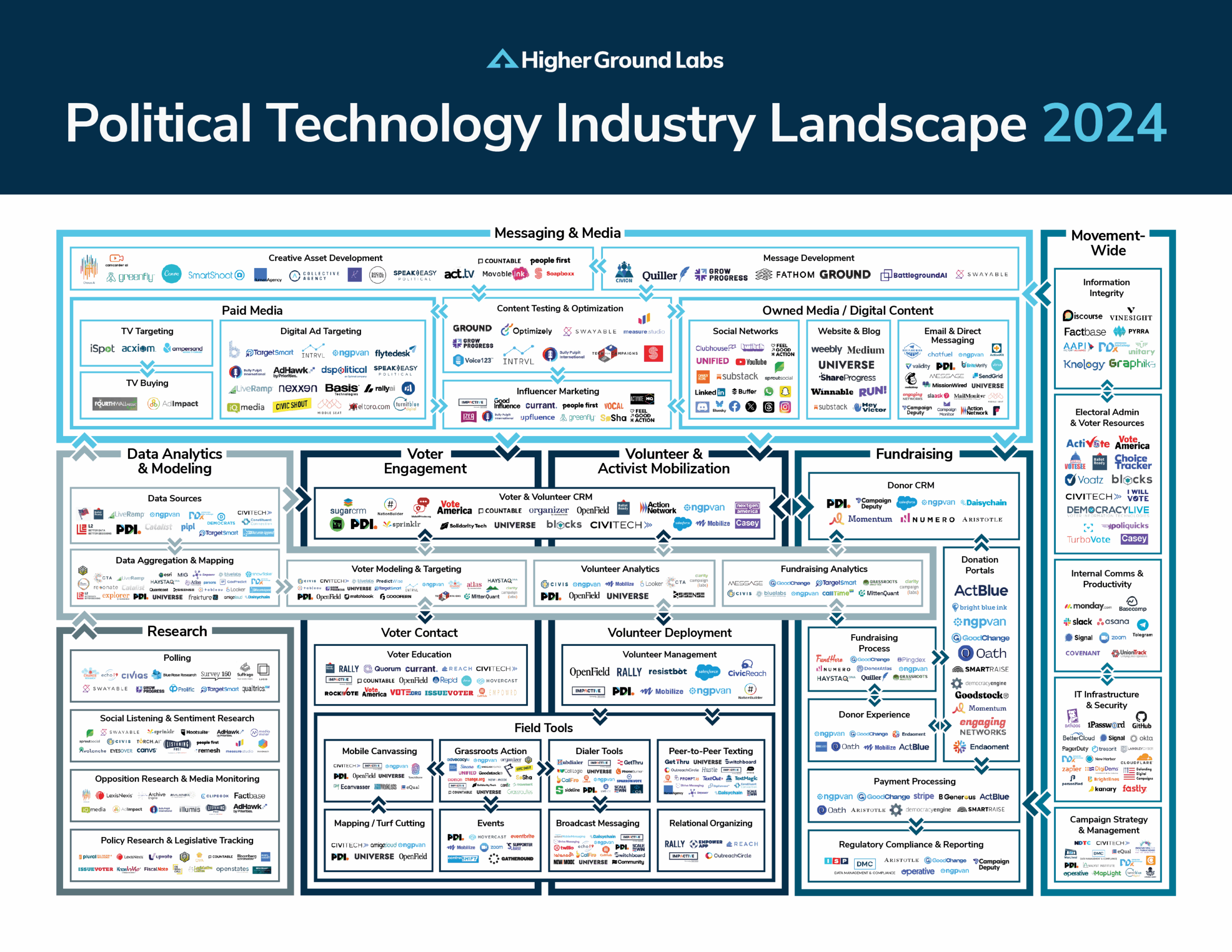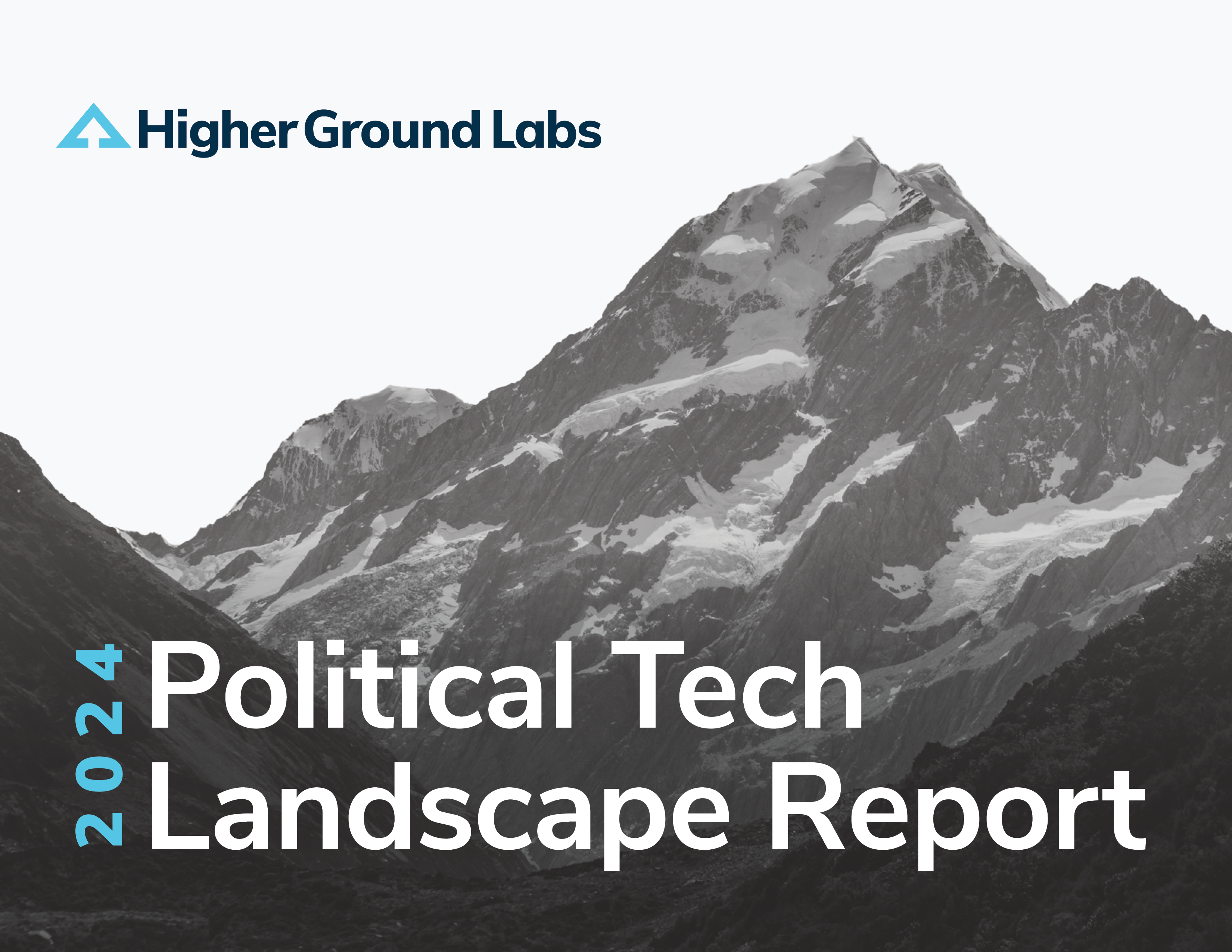Each year, we track developments across the political technology space, providing a window into how our ecosystem is evolving—and what it means for Democratic campaigns and progressive infrastructure. This year’s report focuses on the turbulent 2024 election cycle and the hard lessons it left in its wake.
The 2024 election presented enormous challenges. Despite record-breaking outreach efforts and a resilient digital infrastructure, Democratic campaigns fell short in key areas—struggling to break through the noise, engage priority voters, and counter the scale of conservative media ecosystems. The fallout has been felt widely, from local communities to national institutions.
In the midst of these challenges, there were also signs of progress. Our movement’s technological infrastructure showed real maturity. Innovations in AI, relational organizing, and message testing delivered promising results. Still, many of these breakthroughs remained at the margins—limited by late adoption, inconsistent strategy, and a failure to meet voters where they are. The gap between what is technically possible and what is strategically effective remains too wide.
Our 2024 Landscape Report tracks developments within the political technology industry across six major categories: Media & Messaging, Data Analytics & Modeling, Research, Volunteer & Activist Mobilization and Voter Engagement, Fundraising, and Movement-Wide & Organizational Infrastructure. It highlights emerging trends as well as areas of need and opportunity.

The Executive Summary
CRM instability and political targeting expose infrastructure risks
In 2024, Republicans ramped up attacks on Democratic-aligned infrastructure, aiming to discredit and destabilize core platforms like NGP VAN and ActBlue. At the same time, reliability issues with NGP VAN have raised ecosystem-wide concerns about overreliance on a single CRM, sparking early exploration of alternatives.
Earned media struggles to match the influence of paid digital campaigns
Democrats substantially outspent Republicans in digital advertising, and 2024 marked the first cycle in which influencer marketing became a widespread and institutionally adopted practice. Yet, conservative media achieved significantly greater organic reach across platforms—revealing a critical gap in resource allocation and strategic prioritization within our media approach.
Innovation stalls in voter contact methods
Despite record-scale outreach via text, phone, and door-to-door efforts, declining voter engagement reveals stagnation in effective voter contact strategies, underscoring the need for new methods that prioritize genuine connection and measurable impact, alongside technologies and data that can support them.
Progressive data infrastructure demonstrated strength and resilience amidst integration challenges
The progressive ecosystem demonstrated its most secure and coordinated tech infrastructure to date. Core platforms withstood widespread DDoS attacks, new integrations enabled smoother data flows, and national cell match rates rose to 86%. Major ecosystem-wide efforts—from DDx and Parsons to the Good Catch bug bounty program—reflected years of investment in resilience, security, and interoperability. However, data integration remains a challenge. We saw the entrance of promising new tools and engineering solutions, but with adoption being slow, fragmented practices continue to hinder accurate measurement and cohesive strategic execution.
Movement tech grapples with inconsistent tech adoption
While technology’s role in campaigns continues to grow, both adoption and spending remain inconsistent. Budgets are still allocated too late in the cycle, and campaigns frequently default to familiar tactics over newer approaches, discouraging the integration of innovative tools. This reluctance to adopt tech early and thoroughly limits its potential, reducing efficiency and impact.
Campaigns experiment with AI, but widespread adoption remains limited
Campaigns tested AI-driven tools for qualitative analysis, direct voter contact, and content creation, demonstrating potential for significant time and resource savings. However, most efforts remained experimental, and full adoption was at the margins, underscoring the need for structured training and deeper implementation to realize AI’s full capabilities.
We hope this resource offers insights into the progressive technology landscape that will aid you in the work ahead. A big thank you to the amazing team of researchers who crafted this report and the contributors who shared their experiences.
Help share this resource:
|
Our friends at Higher Ground Labs just released their 2024 Political Tech Landscape Report. It’s a clear-eyed look at what worked, what didn’t, and where the movement needs to evolve after a tough cycle. The report digs into voter engagement gaps, tech adoption challenges, and bright spots in innovation. If you're an organizer, technologist, funder, or practitioner thinking about where we go from here, this is a great resource ⬇️ #PoliticalTechLandscape Our friends at HGL have released their 2024 Political Tech Landscape Report—and it's a critical read. Download to read crucial trends & gaps from the last cycle ⬇️ #PoliticalTechLandscape |





